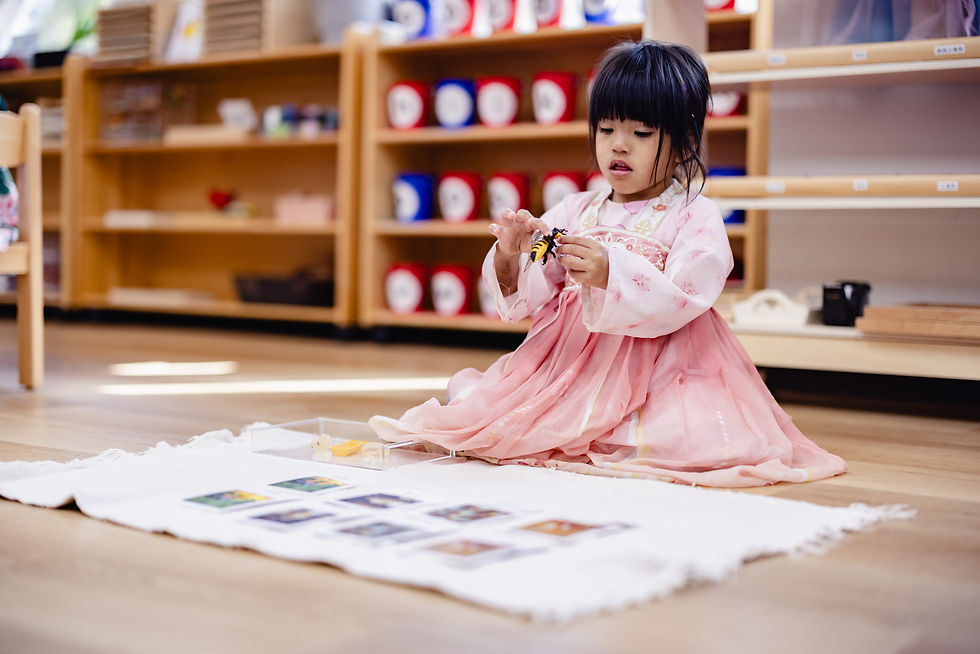Montessori history helps children develop a sense of time and their place within it. Beginning with personal timelines (e.g., “When I was a baby...”), children learn to reflect on their own growth before expanding their understanding to days, months, seasons, holidays, and the larger flow of human history.
Using timelines, calendars, and storytelling, children are introduced to the concept of past, present, and future. They also explore tools like clocks, learning to tell time using the hour and minute hands. Through these experiences, children gain a deep appreciation for change, rhythm, and the meaningful story God is writing in and through their lives.
History


Art in Montessori is more than a subject—it’s a form of self-expression and reflection. Children explore a variety of tools and media such as watercolor, oil pastels, natural elements, and clay. Rather than copying preset models, they are encouraged to explore freely and create from their own ideas and feelings.
Art supports fine motor development, spatial awareness, and emotional expression. More importantly, it teaches children to recognize beauty in the world around them and within themselves, nurturing a sense of joy, confidence, and purpose.
Art
In a Montessori classroom, geography is where children begin to see the world not as a collection of facts, but as a living, interconnected creation. With hands-on materials like puzzle maps, land and water forms, and globe explorations, children gain a concrete understanding of continents, countries, and cultures.
They learn about people around the world—their homes, foods, languages, and traditions—building compassion and curiosity across borders. As they explore, children develop a deep respect for diversity and begin to see their own place in God’s beautifully designed world.
Geography


Science in the Montessori classroom begins with awe and leads to understanding. Children explore the natural world by categorizing and observing it closely—starting with the living and non-living, and gradually moving into studies of plants, animals, vertebrates, invertebrates, and more.
Through real-life observation, nature walks, hands-on experiments, and nature-based activities, children engage deeply with biology, earth science, and physical science. They learn to ask questions like “Why?” and “What happens if…?”, laying the groundwork for critical thinking, care for the environment, and a lifelong love of discovery.
Science
Montessori education emphasizes hands-on learning, self-directed activity, and collaborative play. Teachers introduce each material through intentional lessons, clearly demonstrating its purpose and learning outcomes. After the lesson, children are encouraged to work independently with the material—allowing them to practice skills, explore concepts, and build meaningful connections through repetition and discovery. This approach nurtures confident, capable learners who are motivated from within and well-prepared across all domains of development.
The Montessori curriculum is built around five key areas of study: Practical Life, Sensorial, Mathematics, Language, and Culture. Each area features thoughtfully designed educational materials that increase in complexity as children progress. Students move through the curriculum at their own pace, guided by their individual interests and developmental readiness.
What makes our Montessori Curriculum special?
The Montessori Practical Life curriculum lays the foundation for independence and confidence by engaging children in meaningful, real-life activities. This area includes four key components: care of self, care of the environment, control of movement, and grace and courtesy. Typical Practical Life activities include transferring objects using spoons, tongs, or pitchers; pouring liquids and solids; preparing food such as slicing fruit or peeling vegetables; and caring for the environment by washing tables, watering plants, or sweeping. Children also work with dressing frames to practice skills like buttoning, zipping, and tying. Additionally, they learn important social skills such as polite greetings, table manners, and peaceful conflict resolution.Through repetition and careful guidance, children gain a deep sense of competence and self-discipline, setting the stage for academic and social success.
Practical Life


Sensorial activities in the Montessori classroom are designed to help children refine their five senses—sight, touch, sound, smell, and taste—enhancing their ability to observe, compare, and understand the world around them. By engaging with specially designed sensorial materials, children develop their ability to organize sensory impressions and make sense of their environment.
These activities support the child in recognizing similarities and differences, as well as concepts such as size, dimension, color, texture, sound, and scent. They also promote skills like grading, sequencing, classifying, and sorting. Importantly, sensorial work lays the foundation for more advanced learning in areas such as mathematics, language, and geometry by strengthening the child’s ability to make distinctions, identify patterns, and think logically.
Sensorial
The mathematics curriculum in Montessori education helps children develop an understanding of abstract mathematical concepts and relationships through hands-on, concrete learning experiences. Children have an innate desire for order and logic, and this curriculum nurtures that by guiding them through counting, identifying numerals, matching numerals to quantities, and exploring the decimal system. Using tactile, concrete materials, children begin to grasp the functions of addition, subtraction, multiplication, and division in a way that is both visual and physical. These early, tangible experiences provide the foundation for later practice with memorization and abstract thinking.
Math


The Montessori Language curriculum is designed to provide children with the foundational knowledge and skills necessary to build a rich vocabulary and a strong understanding of language. It fosters a personal interest in reading and supports the development of reading comprehension. The journey begins with pre-reading exercises, followed by work with phonics, letter identification, and letter formation.
Children learn to blend sounds to form words and progress to building both simple and complex sentences. Activities such as sandpaper letters and fine motor exercises like pin-poking support proper pencil grip and prepare children for writing. Oral language skills are nurtured daily through social interaction, group activities, and grace and courtesy lessons, promoting confident and effective communication.

.jpg)